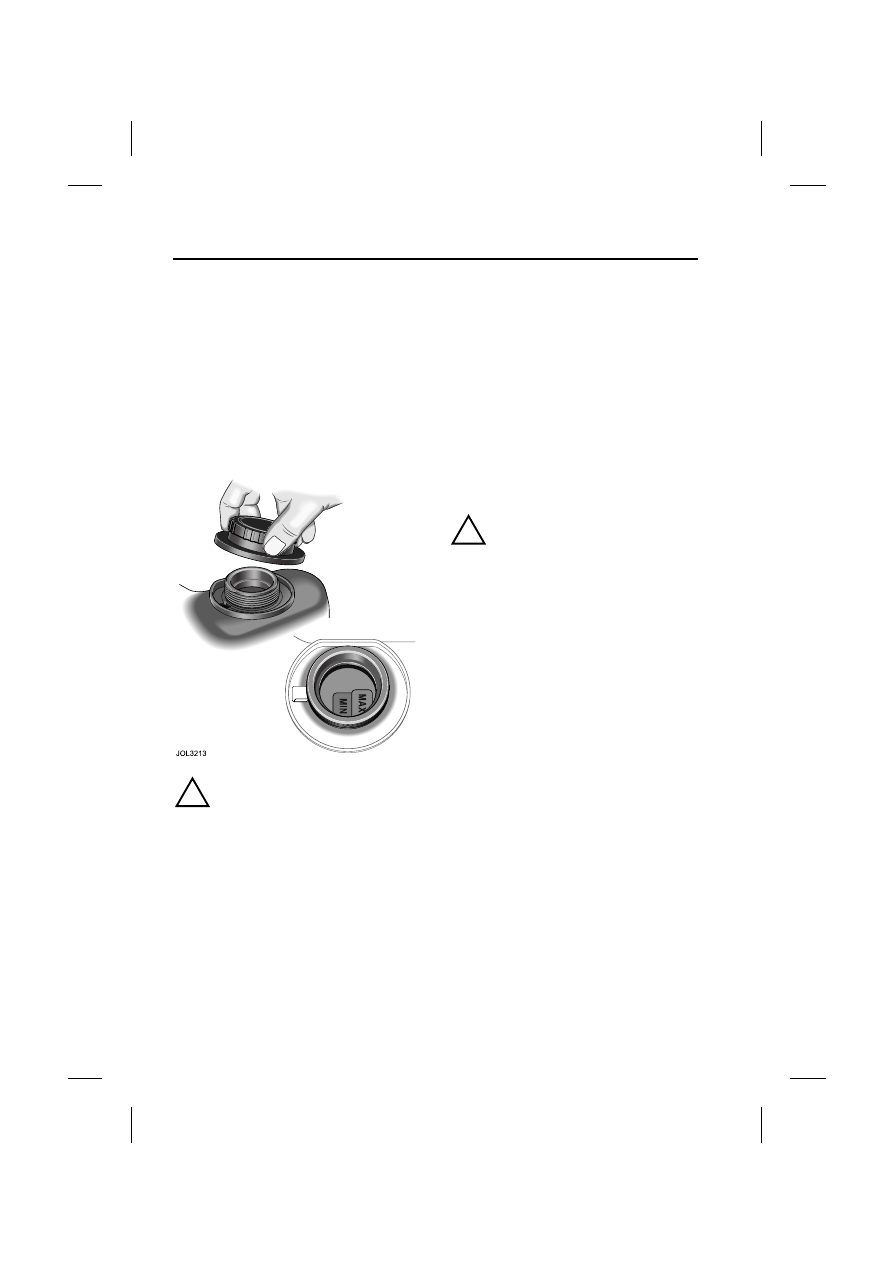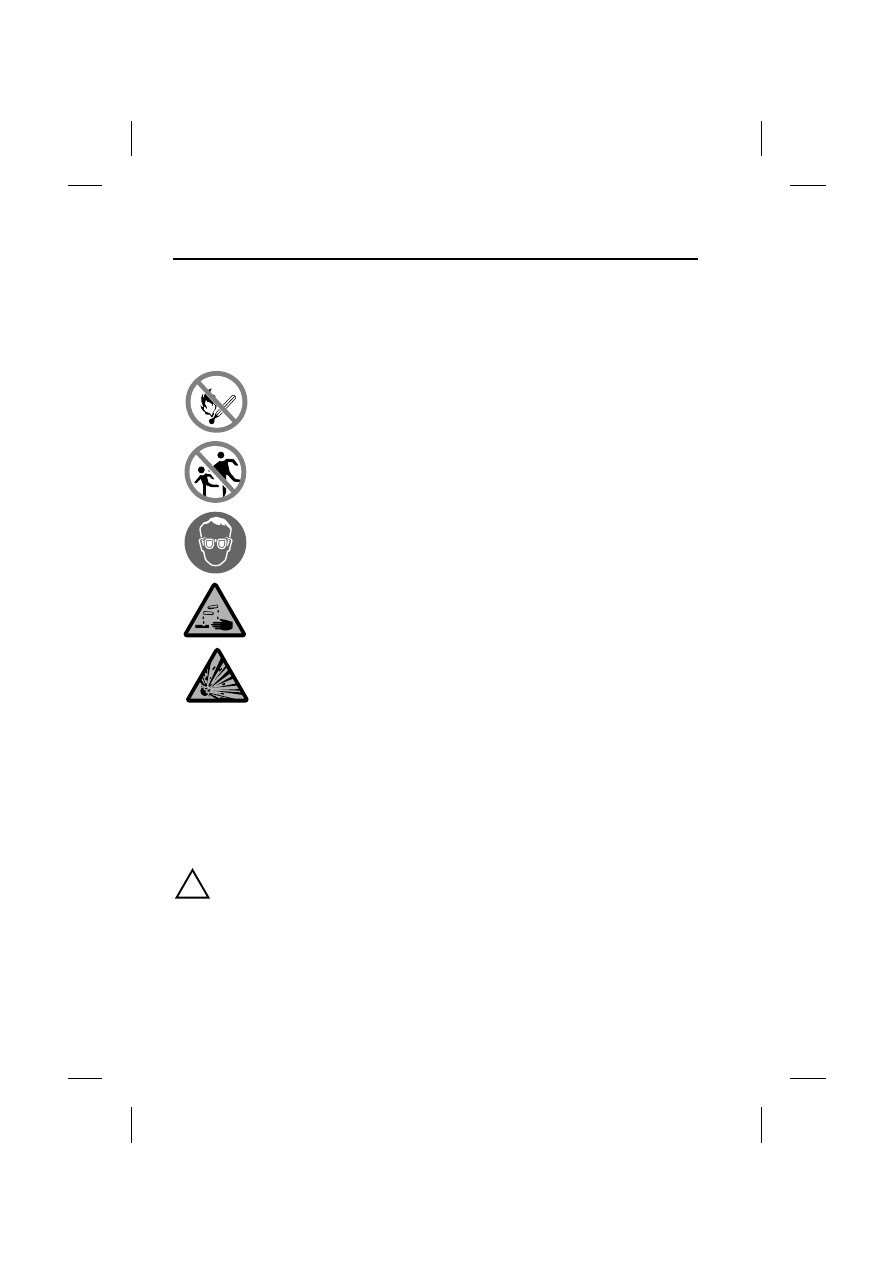Jaguar S-Type. Manual — part 46

Checking and Topping up
192
L
Unscrew the filler cap and top up to the
MAX level. Use Shell DOT4 ESL or a low
viscosity DOT 4 brake fluid that meets ISO
4925 class 6 requirements.
Refit the filler cap securely.
To avoid contamination, if any brake fluid
should be spilt, replace the cap on the
reservoir before cleaning the spilt fluid
from the vehicle.
CHECK COOLANT LEVEL
!
WARNING:
Do not remove the coolant header tank
filler and pressure cap while the engine
is hot. If the cap must be removed,
protect the hands against escaping
steam and slowly turn the cap
counter-clockwise until the steam
pressure starts to escape. Leave the
cap in this position until the pressure is
released, and then remove the cap
completely.
Refer to pages 187, 188 for coolant
header tank location.
The coolant level MAX and MIN
indicators are located inside the reservoir
and are only visible when looking into the
filler neck with the cap removed.
Check the level only when the engine is
cold. The coolant level should be between
the MAX and MIN indicators. If persistent
coolant loss is noticed, contact your
Jaguar Dealer to enable them to
investigate the cause immediately.
Topping up
!
WARNING:
• Do not allow anti-freeze to make
contact with skin or eyes. If this
should happen, rinse the affected
area immediately with plenty of
water.
• Coolant fluid is toxic and in
concentrated form is flammable. Be
sure to observe all warnings
indicated on the container.
Caution: Anti-freeze will damage
paintwork. Avoid spillage.
Top up with a mixture of 50% water and
50% anti-freeze until the coolant is
between the MAX and MIN indicators
inside the header tank. Use anti-freeze to
specification WSS M97B44, coloured
orange, Extended Life Coolant.
Refit the filler cap and hand-tighten
securely until the ratchet operates.

193
Checking and Topping up
R
Engine anti-freeze
When used at the correct concentration,
anti-freeze not only protects the engine
from frost damage in winter, it also
provides all year round protection against
internal corrosion.
The cooling system should always be
topped up or refilled with the specified
anti-freeze at the correct concentration.
This 50/50% mixture gives frost
protection for temperatures down
to –40°C (–40°F).
Do not mix any other anti-freeze with that
specified; inferior quality anti-freeze may
be ineffective in maintaining adequate
frost and corrosion protection to the
cooling system.
The coolant solution may remain in the
cooling system for five years or
250 000 km (156 000 miles) after which
the system should be drained, flushed
and refilled.
CHECK WINDSHIELD AND
HEADLAMP WASHER
RESERVOIR
Refer to pages187, 188, for windshield
washer reservoir location.
The washer reservoir contains the fluid for
the windshield washers and the headlamp
powerwash system.
Fill to just below the neck with Jaguar
windshield Washer Fluid diluted with
clean, preferably soft water, as specified
in the instructions on the bottle. Do not
overfill.
Using a non-approved fluid may
adversely affect the wiper blade rubber,
resulting in ineffectual and noisy wiping.
Cold weather precautions
To prevent damage to the pump during
freezing conditions, use Jaguar
Windshield Washer Fluid at the strength
shown on the bottle, for the anticipated
ambient temperature.
!
WARNING:
• Windshield washer fluid is toxic,
and in concentrated form, is
flammable. Be sure to observe all
warnings indicated on the washer
solution container.
• Under no circumstances must
cooling system anti-freeze be used,
since this will damage the
paintwork.

Battery
194
L
Battery
BATTERY WARNING SYMBOLS
There is a label on the battery depicting a
number of warning symbols. The battery
warning symbols are as follows:
BATTERY CARE
A low maintenance battery, specifically
designed for use with this vehicle, is fitted
in the luggage compartment.
In hot climates more frequent checks of
the battery electrolyte are required. If
necessary, the battery cells can be
topped up with distilled water.
!
WARNING:
• California Proposition 65:
Battery posts, terminals and related
accessories, contain lead and lead
compounds. Wash hands after
handling.
• Do not connect any 12-volt
equipment, (for example, a 12-volt
lead lamp), directly to the battery
terminals. Use the cigar lighter
sockets for temporarily connecting
Jaguar approved accessories.
• The cell plugs and vent pipe must
be in place at all times when the
battery is in the vehicle. Failure to
fit, or incorrect fitting of these items
is potentially hazardous. Make sure
that the vent pipe is free from kinks
or damage.
• To avoid injuries do not use an open
flame or cause an electric spark
when checking the battery.
Hydrogen gas generated by the
battery is flammable and may
explode.
• Do not let battery acid electrolyte
come into contact with skin or
eyes. If you get any in your eyes or
on your skin, immediately rinse with
cold water and consult a doctor.
• Never charge or boost a frozen
battery.
• Switch off the ignition before
disconnecting battery terminals.
Always disconnect the earth
terminal first and reconnect last.
• Do not let battery acid come into
contact with painted surfaces or
fabric.
The exterior of the battery should be
occasionally wiped clean to remove any
dirt or grease.
If a new battery is to be fitted, it must be
the same type as the original.
No smoking, no naked
flames, no sparks (Red)
Keep away from
children (Red)
Shield eyes (Blue)
Battery acid (Yellow)
Explosive gas (Yellow)

195
Battery
R
The use of unapproved batteries is not
recommended and could invalidate the
vehicle warranty.
Note: The service life of the battery is
dependent on its condition of charge. It
must always be sufficiently charged for
the battery to last an optimum length of
time.
We recommend that the battery charge is
checked frequently if the vehicle is used
mostly for short distance trips, or if it is
not used for long periods of time.
BATTERY CHARGING
!
WARNING:
Batteries produce combustible gas
(hydrogen) when being charged. The
battery must be removed from the
vehicle before charging commences.
To disconnect the battery, refer to Battery
lead disconnection see page 195.
When charging the battery make sure that
the charger type and setting is
appropriate for the vehicle battery.
Switch off the charger before connecting
or disconnecting terminal connections to
avoid sparks and short circuits.
Make sure that the charger positive (+)
lead is connected to the positive (+)
terminal of the battery and the negative
(–) lead is connected to the negative (–)
terminal of the battery.
Do not remove or loosen any of the cell
plugs when charging the battery.
Check, and if necessary replenish, the
electrolyte level when the battery is fully
charged.
Battery lead disconnection
Caution:
• Under no circumstances should a
battery be disconnected whilst the
ignition circuit is live, as permanent
damage to the instrument pack
may occur.
• Disconnect the negative lead (earth
terminal) first.
Fold the luggage compartment floor panel
forwards.
Slacken the negative lead pinch bolt and
disconnect the negative (–) battery lead.
Slacken the positive lead pinch bolt and
disconnect the positive (+) battery lead.
Clean the battery posts and coat the post
bases with petroleum jelly.
Battery lead connection
Note: Upon battery reconnection the
security system will be armed. Opening
any protected entry will sound the alarm.
Make sure that an ignition key or key
transmitter is available.
Caution: Do not over-tighten the pinch
bolts.

Нет комментариевНе стесняйтесь поделиться с нами вашим ценным мнением.
Текст